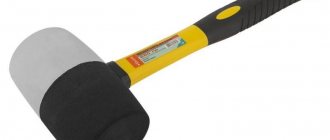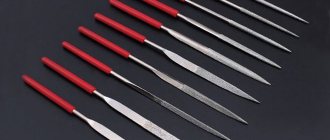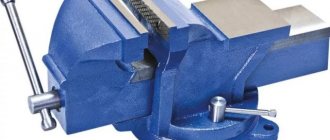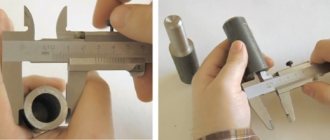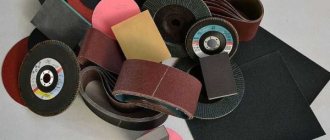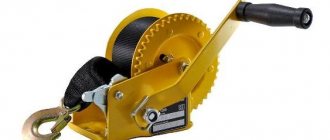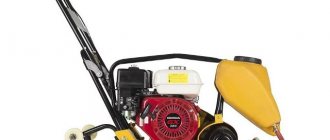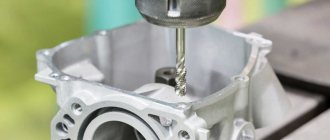Application
Threading tools are divided into types according to design features and application:
- • manual, where the teeth are arranged in a circle. Used in metalwork and manual cutting;
- • nut, for through holes on nuts. With an extended or curved shank;
- • machine, for creating blind holes by machine. Processing takes place on lathes;
- • combined, it is possible to use both manual and machine methods of applying threads to the part.
The tool allows you to apply all types of threads - metric, inch, trapezoidal.
How to choose a thread tap
Next, we'll tell you how to choose a tap for threading. The process takes into account the main characteristics:
- diameter measurement system (inch, metric);
- number of tool passes (one, two, three);
- profile shape (rectangular, trapezoidal, triangular);
- the side in which the screw rotates (left, right);
- placement of threads on the part (inside, outside);
- shape of the part (cone-shaped, cylindrical).
If single products are mainly used to correct broken threads, then sets are used to create a new one. In them, the types of taps for threading are defined as rough, medium and finishing.
Image #3: Standard three-tool tap set
The first is intended for cutting a rough thread, the second for deepening it, the third for finishing it to its final (finish) form. To distinguish one product from the rest in the set, pay attention to the shape of the marks on the tail parts.
- The first tap has the tooth tips cut off and has a smaller outer diameter than the rest of the tools in the set.
- The second one has short tooth segments and has elongated ridges. The diameter of the middle tap is slightly larger than the finishing one.
- The third has a full ridge of teeth and matches the diameter of the future thread.
When calculating the future diameter of the hole, the formula is useful:
Hole D = Tap D * 0.8
Next, when choosing, refer to the table.
Table No. 3: Correspondence between thread diameters and preparation holes
Design features
Any type of tap consists of a working area, a neck and a shank. All mechanical work falls on the working area, which in turn has a intake part and two types of teeth - cutting and calibrating. The role of fastener is performed by the shank, which is fixed on machines in a special thread-cutting chuck, and during manual work in a driver or tap holder. A characteristic feature of hand taps is that they come complete with at least 3 pieces. Each with its own working function: roughing, middle and finishing.
How to cut internal threads with a tap
To create internal threads in finished holes, you need to select the appropriate tap according to size and characteristics. Almost all indicators regarding the choice and quality of threads are regulated by the regulatory document GOST 19257-73. Recommendations for work:
- • for products obtained by casting or stamping, additional preparation is required before applying the thread. The hole is countersinked or drilled to increase the diameter;
- • for accurate and high-quality threads, it is recommended to mount the tap shank in chucks with reversible, self-centering and floating properties;
- • all processed workpieces are first chamfered;
- • during the cutting process, cooling and lubricating solutions must be used.
Thread types: metric, inch and pipe.
- Metric - thread parameters are measured in mm, with the corresponding marking “M”.
- Inch - used for conical taps, measured in inches.
- Pipe – for cylindrical taps, threads are applied to pipe connections.
You can make a thread in a finished metal hole or nut in literally seconds if you have a tap. Using this metal-cutting tool, you can apply internal threads and calibrate existing ones.
Of course, taps are not the only tool used to create threads. For example, dies and blanks fall into a similar category. They are used to apply threads to the outside of a part. But that’s not about that now.
There are quite a few types of taps; experienced craftsmen have never even heard of some of them. Therefore, we will leave the specific types of this tool to highly specialized specialists and analyze the most popular ones.
Let's try to choose a tool for specific needs. Using the algorithm presented below, this will not be difficult to do.
Step 1. Application areas: home workshop or production
Obviously, when working at home and in production, the master will need different tools.
Hand taps
(they are also locksmiths) can be found in any workshop. Due to its significant strength and wear resistance, the tool allows you to perform high-precision work even in domestic conditions. They are usually equipped with a special crank necessary to rotate the tap.
Hand taps are almost always sold in sets of 2-3 pieces of various diameters. Each tool performs its task: one performs rough thread processing, the second (if any) does intermediate processing, the third does finishing, after which the profile meets all GOST standards (more on them below).
But hand taps are not designed to operate at high rotation speeds. For this, machine analogues are used.
Machine taps
Made from higher quality high-speed steel, which can easily withstand the severe heat that occurs due to friction and cutting metal. It is in terms of strength that metalworking taps are inferior to their machine counterparts. In addition, machine tools have a small intake part, because The alignment of the tap and the workpiece hole is ensured by the design of the machine.
There is also a third type of taps - nut
. It is easy to guess that they are used exclusively for threading nuts.
Nut taps have a long shank, which is installed in a special automatic machine. After the threads are applied, the nuts are moved one by one to the tail section and wait there until the entire series is completed. The tap is then removed from the chuck and all nuts are dumped into the receiving tray. This significantly saves operating time and increases productivity.
Step 2. Hole type: blind or through
The purpose of your work is of no small importance: are you going to create a profile in a blind hole or a through hole? Depending on this, you will need different tools. In particular, the chip flutes on the tap will play an important role. They can twist (both to the left and to the right), or they can be positioned straight.
Straight-line
grooves are used in universal taps.
Tools with right groove recess
More often used to create a profile in blind holes. Along these grooves, the chips are squeezed back outward and do not clog the hole.
Left-directed helical grooves
used to create a profile in through holes. The chips are forced out directly in front of the tap, thereby protecting the newly applied threads from damage.
There is also an option for taps with shorter flutes, known as fluteless taps.
, or raskatniki. This design helps create threads in products made from ductile materials, for example, alloyed high-strength and low-carbon ductile steels, as well as aluminum alloys.
Step 3: Thread Type
In production, there are several state standards that differ in the measurement system. Using the markings on the tap, you can understand which of them the tool belongs to - metric or inch. Based on the type of tap device, three types of threads can be applied.
Metric thread
Metric taps are useful for creating a profile whose dimensions are measured in millimeters. They are marked with the symbol “M”.
The profile of taps of this type is an isosceles triangle with an apex angle of 60°.
The size range of metric taps is quite extensive - with their help you can create almost any profile. Each tap size has its own main pitch - the distance between the threads. The larger the size, the larger the main step. To select a tool, a special table is used based on state standards (according to GOST 19257-73).
Inch thread
Unlike metric ones, the size of inch taps is indicated in inches. This system came to us from abroad. In particular, from the USA and Great Britain.
The main pitch is indicated by the number of threads (or number of turns) per 1 inch. The higher the number, the finer the thread pitch.
The vertex angle in inch threads can be different. The 60° angle is typical for taps common in North America. UNC thread has gained maximum popularity. Such fasteners are often found on equipment imported to Russia (lawn mowers, generators, cultivators, etc.).
British standard BSW inch threads have a tip angle of 55°.
Below are the inch sizes of taps of the most popular standards.
Pipe thread
Among inch taps, it is worth highlighting a group of tools used to create a profile in pipe connections. Pipe threads are especially common in elements of water supply systems.
The dimensions of the pipe taps are specially adjusted to standard types of metal pipes. They are divided into cylindrical
and
conical
. The first ones are designated by the letter “G”, followed by a number corresponding to the bore diameter. Tapered pipe taps are marked with the symbols “R” or “Rc”. The thread is applied to the surface with a taper of 1:16 and reaches the stop.
Traditionally, their sizes are indicated in inches. However, over time, the designation system has lost its identity with the actual dimensions, so tools for pipe threads are selected according to tables (based on GOST 6357-81 and GOST 6111-81).
GOST requirements
State standards determine the requirements for the dimensions and characteristics of taps, and also introduce maximum tolerances, accuracy class and degree of surface roughness. Almost all indicators for the choice and quality of threads are regulated by GOST 3266-81, which you can.
Machine and machine-hand taps
To calibrate and create threads in blind and through holes of various shapes, a tool is used - a tap, machine or machine-hand type.
— Machine metal-cutting tools are used to work on lathes, drilling, aggregate and turret machines to cut threads of all types. They process products much faster and can be used for conveyor production and large orders. With this type of equipment you can cut threads in one go if you need threads with pitches of up to three millimeters. Coarse pitch threads are made using several passes using a tap on the metal product.
— Machine-manual equipment can be used to cut threads both manually and using drilling devices (machines). The tool is available in quantities of one or two pieces. In a set of two taps, one metal-cutting tool is used for roughing work, and the other for finishing work. Often a set of machine-manual equipment is used to work with different types of materials: mild steel and cast iron are processed with one tool, and hard steel is processed with two taps. Machine-manual types differ from simply manual thread cutters in the type of shank - there is a square and an annular recess, thanks to which the equipment does not fall out of the chuck during processing of products. A machine-made product for working with metal can make threads in automotive parts, cut fastening threads and small-metric, cylindrical and conical threads. In through armholes and blind ones.
Types of taps and their purpose
The purpose of taps varies, so each type of work requires its own tool. Let's talk about the main varieties.
Image No. 2: Tap device
- Manual/machine. Choose the option that is designed for the appropriate type of work. In this case, pay attention to the design of the product (screw, straight, with shortened grooves).
- Nuts. Single tool for straight through threads. It is longer than the machine-manual one and has a sharp approach, similar to the first number of the complete tap.
- With cut thread. The tool is suitable for processing sheets and cutting holes in plate metal.
- Locksmiths. Designed for manual cutting of holes. Supplied in sets consisting of three tools (roughing, finishing, medium). The work begins with a rough hole, the hole is adjusted with the middle one and polished with a finishing element.
- Conical. Suitable for threading through holes. The intake part of the products has an incomplete thread, and the calibrating part has a full thread.
- Poleshechnye. Suitable for making pre-threads. They have large intake cones.
- Uterine. Used for cleaning threads. The main difference from other types is the presence of a spiral on the right side.
- Grooveless. Suitable for long-term work with high productivity. The product has a short receiving cone base without longitudinal grooves, which reduces the likelihood of breakdowns.
- Combined. These are products made up of two parts (roughing and finishing, connected by a neck). The combined type tool reduces the time needed to complete the work. For example, you can buy a tap drill that is suitable for both drilling and tapping.
- Special. Products have a narrow specialization. This type includes attachment, ship and tandem taps.
Taps - broaches
To obtain large-profile threads in metal products, use a broach tap. It is used to process complex through or trapezoidal holes. Broaches can only be used in a lathe. The thread is cut in one pass along the hole. This tap differs from other types in its more precise design and rigidity. It works in tension rather than compression like conventional threading tools. Due to the broaching function, the thickness of the cut is reduced, and the length of the cutting part is increased.
Nut taps
Nut-type tools are designed for thread cutting in nuts of different diameters. The design of the nut tap is such that the tool does not need to be turned out at the end of the nut hole machining process. Nut accessories can be with different shanks: curved and elongated. With curved ones - used in working with automatic nut-tapping machines. The shank of a nut tap is, in any case, longer than that of other types; this is necessary in order to string nuts onto it as threads are cut into them. This increases speed and productivity.
Classification by hole type
Different taps can make holes of different shapes. There are tools for:
- Through holes. The inlet area of the nozzle is increased in length and practically merges with the working part. To apply cutting with such a tap, an electric drive is used.
- Blind holes. The entrance area has a shape similar to a cutter. Thanks to this, threads can be applied to the entire depth of the hole. Care must be taken when inserting the tap as it may crack. When working with such a tool, manual cutting is most often used.
Bench taps
To work with holes of different types and shapes, craftsmen take a set of metalworking taps. Thread-cutting equipment is manufactured in sets that include roughing cone-shaped tools, semi-finishing and finishing cylindrical equipment. Using metalworker's taps you can process the part manually. Using a set of metal-cutting equipment, a master can cut large and metric threads. Taps for metalwork are left and right depending on the direction of their rotation.
Main types of tapping threads
Most often, taps are used to cut threads of three main types. The following types of tools are used.
- Metric taps. Designed for cutting metric threads. This is the most common type of fastening connections.
The metric thread profile is an equilateral triangle. The apex angle is 60°. The tops of the protrusions are cut off.
Image #9: Metric thread profile
- Inch taps. The working parts of such devices have a conical shape. The inch thread profile looks like this.
Image No. 10: inch thread profile
Diameter is measured in inches and pitch is measured in threads per inch.
- Cylindrical and conical pipe taps. Used to create reliable pipe connections.
Image #11: Pipe thread profile
- Check out the standard specifications for the types of threads listed above.
Image #12: Standard specifications for metric, imperial and pipe threads
Using this table, craftsmen select thread-cutting tools.
What materials are taps made from?
Metal-cutting tool dies are made from high-quality steel of different grades: tool, high-speed, alloy. Modern production technology allows taps to be made from carbide steel and powder steel; in the latter case, the tool is produced by sintering powders. Taps made of carbide alloys are of higher quality, as they are resistant to high temperatures, wear-resistant and can work for a long time at high speeds, which allows processing a large number of metal products. Tools made from steel powders also have their advantage - high strength due to the lower hardness of the tool.
GOST standards
Machine-manual with straight/helical/shortened grooves made of carbon steel are regulated by GOST3266-71-71/GOST17933-72/GOST 17931-72. Nut taps with straight/curved shank are made from low-alloy steel in accordance with GOST1604-71/GOST6951-71. Machine-manual, where the teeth are staggered, made of stainless steel - GOST 17927-71. Nuts with a staggered arrangement and a straight shank (taps made of heat-resistant steel) in accordance with GOST 17929-72. Machine tools with screw or shortened types of grooves (tools made of light alloys) - GOST 17932-72/17930-72.
GOST
GOST 3266-81 is developed for manual and machine versions of the tool. For nut models, GOST 1604-71 is provided, and GOST 6951-71 was created for products with a curved shank.
Accuracy classes
The degree of accuracy is characterized, first of all, by the tolerance on the average thread diameter.
Based on the information provided in GOSTs, the following conclusions can be drawn regarding the compliance of the tool type with the accuracy class:
- Accuracy degree 1, 2 and 3 – metric taps (both nut and machine-hand).
- Accuracy class A2, A3, B1 – pipe models.
- C and D – inch.
- Class 4 – hand tools.
Marking
The inscriptions on the tool indicate the main and additional characteristics of the tap (an example is given in parentheses).
Marking begins with the type and size of thread (M10), then comes the accuracy class according to PN-ISO (ISO2) or DIN (H6).
If the thread is left-handed, the abbreviation LH is added. In the case where the thread has a non-standard pitch, the pitch designation is indicated after the thread diameter.
If the tool is made of hardened stainless steel, it receives the HSS designation.
In addition to the main markings, the tail section may contain the following information:
- Thread run-out;
- Angle of inclination of grooves;
- Spiral groove pitch;
- Direction of rotation of the grooves;
- Material of manufacture;
- Application group;
- Internal cooling;
- Digits of the production batch number.
Preparing for Threading
The hole is prepared in several ways before cutting a thread - by sharpening, grinding or drilling the surface of a metal workpiece. For external threads, the diameter must be reduced by 0.1 - 0.4 millimeters. At the beginning of the section where the thread will be, a chamfer is made by sharpening - this is necessary to dull the entry of the thread. And if the hole is bored before threading, its diameter increases to 0.4 mm. The hole for the thread should be slightly larger in diameter than the diameter of the thread itself - this helps prevent breakage of the thread-cutting equipment.
Design
There are several dozen designs of taps for thread cutting. Each is adapted to a specific production task. According to this classification, the following types are distinguished:
- Grooveless. Used for aluminum and its alloys.
- With staggered teeth. In this way, friction is reduced when processing viscous materials.
- Stepped. The tool is conventionally divided into 2 sections, one of which carries out cutting, and the other smoothes.
- Combined. The most common option is a tap drill or a broach tap.
- With a channel for coolant supply. This increases labor productivity and the life of the tap.
- Bells. Allows you to obtain threads with a diameter from 50 to 400 mm. The number of feathers reaches 16 pieces.
How to remove a broken tap from a hole
The tap may break if the thread is cut into a hole with a small diameter, and chips may become trapped when the tool is removed.
Extraction methods
- 1. The double ends of the rigid wire must be inserted into the grooves of the tap and unscrewed;
- 2. You can weld the handle to the broken instrument and use it to remove it;
- 3. There are special mandrels and countersinks that will help cope with this problem;
- 4. If part of the tap remains outside, you can weld a shank with a square tip to it;
- 5. Drilling with screw drills;
- 6. Burning with electrical erosive machines;
- 7. Etching with dilute nitric acid.

